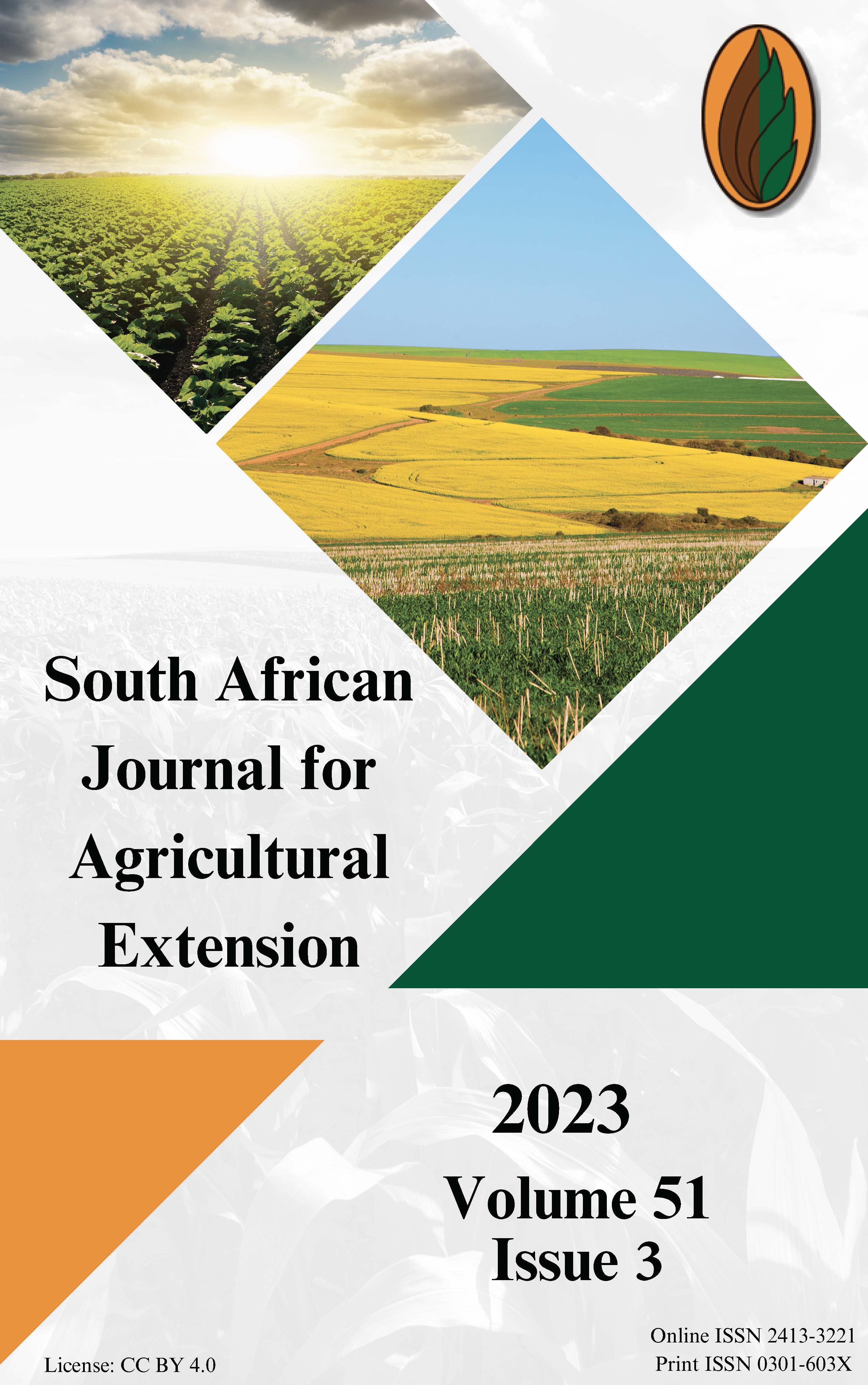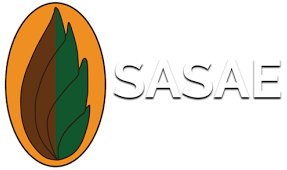Farmers' Production Practices, Incidence and Management of Pests and Diseases, Extension Services, and Factors Limiting Cotton Production and Quality in South Africa
DOI:
https://doi.org/10.17159/2413-3221/2023/v51n3a14462Keywords:
Cotton, Insect pests, Diseases, Integrated pest management, Farmers' knowledgeAbstract
Cotton is one of the essential cash crops; however, several factors, such as low yields and pest and disease infestations, affect the production. In South Africa, cotton production has increased among small-scale farmers since the late 1990s. Although the crop is not new to South African farmers, no recent information reflects the current status of cotton production practices. A study evaluated farmers' production practices, the incidence and management of pests and diseases, extension services, and factors limiting cotton production and quality in South Africa. One hundred and forty farmers, mainly smallholder farmers, were interviewed during the 2017/18 growing season. Most farmers planted genetically modified (GM) cotton on less than 5 ha of cotton, with 96% planting under dryland. Most farmers neither practised conservation agriculture (95%) nor conducted soil analyses (87%). A mean cottonseed yield of 700 kg ha-1 was reported on dryland cotton, and 5 000 kg ha-1 was obtained from irrigated cotton. Most of the farmers (99%) harvested their cotton by handpicking. Farmers' pest knowledge was higher than their knowledge of different diseases. Most participants were unaware of nematodes (88%) or disease-resistant cultivars (74%), while 91% were aware of insect-resistant cultivars. Extension officers only mentored and supported many respondents (82%). Most farmers (93%) relied on pesticides to control cotton pests, and the rest (7%) used biological control. Climatic conditions (98%), labour costs (88%), and insect infestations (42%) were identified as the main constraints in cotton production. Although this study had a limited number of surveyed farmers, it gives some insight into their knowledge and challenges.
Downloads
References
BOMAN, R. & LEMON, R., 2005. Soil temperatures for cotton planting. Available from http://cotton.tamu.edu/General%20Production/scs-2005-17%20Soil%20Temp.pdf.
BOYER, C., HARMON, X., LAMBERT, D., LARSON J. & DONALD, T., 2017. Risk effects on nitrogen fertilisation and cost-share payments under alternative tillage and cover crop systems for cotton. Paper presented at the 2017 Annual Meeting, 4-7 February, Mobile, Alabama 252482, Southern Agricultural Economics Association.
BROWN, B., NUBERG, I. & LLEWELLYN, R., 2017. Stepwise frameworks for understanding the utilisation of conservation agriculture in Africa. Agric. Syst., 153: 11-22.
BURKE, I.C., TROXLER, S.C., WILCUT, J.W. & SMITH, W.D., 2008. Purple and yellow nutsedge (Cyperus rotundus and C. esculentus) response to postemergence herbicides in cotton. Weed Technol., 22(4): 615-621.
CHAPEPA, B., CHITAMBA, J., MANJERU, P. & MUDADA, N., 2013. Screening of Gossypium hirsutum germplasm against Verticillium dahlia Kleb by natural infection. Int. J. Agron. Agric. Res., 3(1): 26-31.
CHAPEPA, B., MANJERU, P., NCUBE, B., MUDADA, N. & MUBVEKERI, W., 2015. Diallel analysis on variation of Verticillium wilt resistance in upland cotton grown in Zimbabwe. Afr. J. Agric. Res., 10(2): 39-48.
CHAUDHRY, R., 2008. Update on costs of producing cotton in the world. In Proceedings of the 29th International Cotton Conference, Bremen, Germany, 3-5.
CERTI-PIK., 2017. Difference between cotton strippers & cotton picker spindles. Available from https://certipik.com/2017/10/whats-the-difference-between-cotton-strippers-and-cotton-picker-spindles/.
COLEMAN, A., 2019. Cotton can be more profitable than maise. Farmer's Weekly. Available from https://www.farmersweekly.co.za/crops/field-crops/cotton-can-be-more-profitable-than-maize.
COTTON SOUTH AFRICA., 2017. Cotton hectares planted and yield for the Republic of South Africa. Available from https://cottonsa.org.za/wp-content/uploads/06-Cotton-Hectares-Planted-and-Yield-20.pdf.
COTTON SOUTH AFRICA., 2018. Cotton Market Report. Available from https://cottonsa.org.za/wp-content/uploads/09-Cotton-SA-Market-Report-Oct-2018.pdf.
KERR, B., 2016. Beware the nutsedge. Farmer's Weekly. Available from https://www.farmersweekly.co.za/farm-basics/how-to-crop/beware-the-nutsedge.
DEPARTMENT OF AGRICULTURE, FORESTS AND FISHERIES., 2011. A profile of the South African cotton market value chain. Pretoria, South Africa: Department of Agriculture, Forests and Fisheries (DAFF).
DESHMUKH, A.S. & MOHANTY, A., 2016. Cotton mechanisation in India and across globe: A review. IJARSE., 3(1): 66-74.
DIARRA, A., BARBIER, B., ZONGO, B.E.E. & YACOUBA, H., 2017. Impact of climate change on cotton production in Burkina Faso. Afr. J. Agric. Res., 12(7): 494-501.
DIPPENAAR, M.C., 2015. Establishing cotton. Available from https://cottonsa.org.za/2015/12/02/establishing-cotton.
FITT, G., WILSON, L., MENSAH, R. & DALY, J., 2009. Advances with integrated pest management as a component of sustainable agriculture: the case of the Australian cotton industry. In R. Peshin & A.K. Dhawan (eds.), Integrated Pest Management: Dissemination and Impact. Dordrecht: Springer.
FOURIE, D., VAN DEN BERG, J. & DU PLESSIS, H., 2017. Evaluation of the susceptibility status of spiny bollworm Earias biplaga (Walker) (Lepidoptera: Noctuidae) to Bt cotton in South Africa. Afr. Entomol., 25(1): 254-258.
GAUTAM, H., SINGH, S., PRASHAD, H., KUMAR, A., CHOUDHARY, A., KAUR, H., NARAYAN, O.P., LAL, S.K. & MEHTA, S., 2023. Pesticide toxicity and their impact on plant growth, active constituents and productivity. In A. Husen (ed.), Plants and their Interaction to Environmental Pollution. Elsevier.
GOUSE, M., KIRSTEN, J.F. & JENKINS, L., 2003. Bt cotton in South Africa: Adoption and the impact on farm incomes amongst small-scale and large-scale farmers. Agrekon, 42(1): 15-28.
GRABOWSKI, P. & HAGGBLADE, S., 2016. The economics of conservation agriculture in Africa: Implications of climate change. In: R. Lal, D. Kraybill, D. O. Hansen, B.R. Singh, T. Mosogoya & L.O. Eik (eds.), Climate Change and Multi-dimensional Sustainability in African Agriculture. Springer: Cham, 659-677.
GWARAZIMBA, V., 2009. Cotton and cassava seed systems in Malawi, Mozambique and Zambia. Paper commissioned by FAO under the All ACP Agricultural Commodities Programme, FAO, Harare, Zimbabwe.
HARPER, D.C., 2011. Soil test information in cotton production: Adoption, use, and value in potassium management. Master's Thesis, University of Tennessee, Knoxville, Tennessee.
HILLOCKS, R.J., 1995. Integrated management of insect pests, diseases and weeds of cotton in Africa. Integr. Pest Manag. Rev., 1(1): 31-47.
INTERGOVERNMENTAL PANEL ON CLIMATE CHANGE., 2007. Climate Change 2007: Synthesis report, contribution of working groups I, II and III to the fourth assessment report of the Intergovernmental Panel on Climate Change. Geneva, Switzerland.
JAMES, C., 2014. Global Status of Commercialised Biotech/GM Crops: 2014. ISAAA Brief No. 49. International Service for the Acquisition of Agri-biotech Applications. Ithaca, NY.
JHA, P., NORSWORTHY, J.K., MALIK, M.S., BANGARWA, S.K. & OLIVEIRA M.J., 2006. Temporal emergence of Palmer amaranth from a natural seed bank. Proceedings - Southern Weed Science Society., 59: 177.
JHA, P. & NORSWORTHY, J.K., 2009. Soybean canopy and tillage effects on emergence of Palmer amaranth (Amaranthus palmeri) from a natural seed bank. Weed Sci., 57: 644–651.
KARAVINA, C., MANDUMBU, R., PARWADA, C. & MUNGUNYANA, T., 2012. Variety and planting date effects on the incidence of bollworms and insect sucking pests of cotton (Gossypium hirsutum L.). Res. J. Agric. Sci., 3(3): 607-610.
KLOSTERMAN, S.J., ATALLAH, Z.K., VALLAD, G.E. & SUBBARAO, K.V., 2009. Diversity, pathogenicity, and management of Verticillium species. Annu. Rev. Phytopathol., 47: 39-62.
KRANTHI, S., KRANTHI, K.R., RODGE, C., CHAWLA, S. & NEHARE, S., 2019. Insect resistance to insecticides and Bt Cotton in India. In R. Peshin & A.K. Dhawan (eds.), Natural Resource Management: Ecological Perspectives. Cham: Springer. 185-199.
KRZYZANOWSKI, F.C. & DELOUCHE, J.C., 2011. Germination of cotton seed in relation to temperature. Revista Brasileira de Sementes., 33(3): 543-548.
LI, H., JI, R., ZHANG, J., YUAN, X., HU, K. & QI, L., 2010. WEB-based intelligent diagnosis system for cotton diseases control. International Conference on Computer and Computing Technologies in Agriculture. Berlin, Heidelberg: Springer. 483-490.
MAPOPE, N., 2001. Verticillium wilt survey in cotton. Research Institute Annual Report, Department of Research and Specialist Services. Zimbabwe: Ministry of Agriculture.
MANJUNATH, T.M., 2004. Bt cotton in India: The technology wins as the controversy wanes. Paper presented at the 63rd Plenary Meeting of International Cotton Advisory Committee (ICAC) Meeting, Mumbai.
MASINJILA, S., 2018. Lessons from Africa's largest producer of GMO crops. Food and Farming Science, Food Law and Politics, African Centre for Biodiversity. Available from https://routetofood.org/lessons-from-africas-largest-producer-of-gmo-crops/#:~:text=South%20Africa%20is%20the%20ninth,the%20continent%20to%20do%20so. (Accessed 25 September 2020).
MIDEGA, C.A., NYANG'AU, I.M., PITTCHAR, J., BIRKETT, M.A., PICKETT, J.A., BORGES, M. & KHAN, Z.R., 2012. Farmers' perceptions of cotton pests and their management in western Kenya. Crop Prot., 42: 193-201.
NORSWORTHY, J. K., GRIFFITH, G.M., SCOTT, R.C., SMITH, K.L. & OLIVER, L.R., 2008. Confirmation and control of glyphosate-resistant palmer amaranth (Amaranthus palmeri) in Arkansas. Weed Technol., 22: 108–113.
NORTON, G.A. & MUMFORD, J.D., 1993. Decision tools for pest management. Wallingford Oxon: CAB International.
NTOW, W. J., GIJZEN, H. J., KELDERMAN, P. & DRECHSEL, P., 2006. Farmer perceptions and pesticide use practices in vegetable production in Ghana. Pest Manag. Sci., 62: 356–365.
PRUDENT, P., LOKO, S., DEYBE, D. & VAISSAYRE, M., 2007. Factors limiting the adoption of IPM practices by cotton farmers in Benin: A participatory approach. Exp. Agric., 43: 113-124.
REINHARDT, C., 2016. Thread of herbicide-resistant weeds in soya beans: prognosis for South Africa in light of global trends: chemicals and fertiliser. Oilseeds Focus., 2(1): 11-13.
SANDHAR, N.S., 1999. Mechanised picking of cotton in Punjab some experiences. Agricultural Engineering Today., 23(5 & 6): 21-27.
SELLERS, B.A., SMEDA, R.J., JOHNSON, W.G. & ELLERSIECK, M.R., 2003. Comparative growth of six Amaranthus species in Missouri. Weed Sci., 51: 329–333.
SINZOGAN, A.A.C., VAN HUIS, A., KOSSOU, D.K., JIGGINS, J. & VODOUHÈ, S., 2004. Farmers' knowledge and perception of cotton pests and pest control practices in Benin: results of a diagnostic study. NJAS - Wagening. J. Life Sci., 52(3-4): 285-303.
TIBUGARI, H., MANDUMBU, R., JOWAH, P. & KARAVINA, C., 2012. Farmer knowledge, attitude and practice on cotton (Gossypium hirsutum L.) pest resistance management strategies in Zimbabwe. Arch. Phytopathol. Plant Prot., 45(20): 2395-2405.
TIGGA, A., PATIL, S.S., EDKE, V., ROY, U. & KUMAR, A., 2017. Heterosis and inbreeding depression for seed cotton yield and yield attributing traits in intra-hirsutum (G. hirsutum L. X G. hirsutum L.) hybrids of cotton. Int. J. Curr. Microbiol. Appl. Sci., 6(10): 2883-2887.
THIERFELDER, C., MATEMBA-MUTASA, R., BUNDERSON, W.T., MUTENJE, M., NYAGUMBO, I. & MUPANGWA, W., 2016. Evaluating manual conservation agriculture systems in southern Africa. Agric Ecosyst Environ., 222: 112-124.
THOMSON, J.A., 2016. Genetically modified crops in South Africa. Innovative farming and forestry across the emerging world: the role of genetically modified crops and trees. In S. De Buck, I. Ingelbrecht, M. Heijde & M. Van Montagu (eds.), Innovative farming and forestry across the emerging world: The role of genetically modified crops and trees. Gent, Belgium: International Industrial Biotechnology Network.
TOWNSEND, T., 2020. World natural fibre production and employment. In R.M. Kozlowski, & M. Mackiewicz-Talarczyk (eds.), Handbook of natural fibres: Volume 1: Types, properties and factors affecting breeding and cultivation. Cambridge, UK: Woodhead Publishing.
TRAPERO, C., RALLO, L., LÓPEZ‐ESCUDERO, F.J., BARRANCO, D. & DÍEZ, C.M., 2015. Variability and selection of Verticillium wilt resistant genotypes in cultivated olive and in the Olea genus. Plant Pathol., 64(4): 890-900.
TSROR, L., 2011. Epidemiology and control of Verticillium wilt on olive. J. Plant Sci., 59: 59-69.
UNITED STATES DEPARTMENT OF AGRICULTURE., 2017. Biotechnology in South Africa: Agricultural biotechnology annual. Available from https://www.fas.usda.gov/data/south-africa-agricultural-biotechnology-annual-1.
WORLD TRADE ORGANIZATION., 2019. World Cotton Day: Why Cotton Matters to Us. Geneva, Switzerland: World Trade Organization Agriculture and Commodities Division.
YUAN, Y., FENG, H., WANG, L., LI, Z., SHI, Y., ZHAO, L., FENG, Z. & ZHU, H., 2017. Potential of endophytic fungi isolated from cotton roots for biological control against Verticillium wilt disease. PLOS ONE., 12(1): e0170557.
Downloads
Published
Issue
Section
License
Copyright (c) 2023 L.N. Malinga, M.D. Laing

This work is licensed under a Creative Commons Attribution 4.0 International License.








.png)